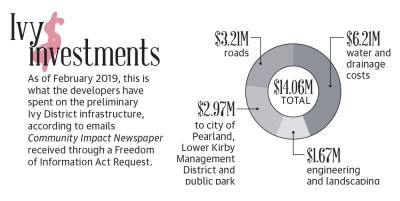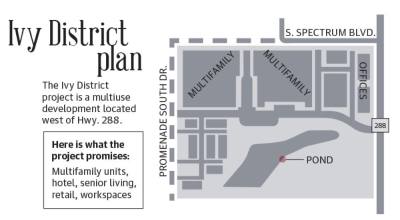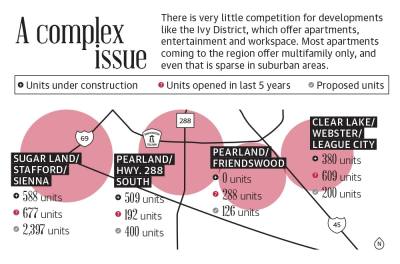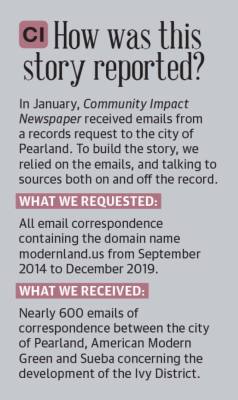Since 2016, developer-funded roads and infrastructure for the development have been built near Hwy. 288. However, work has yet to begin on the project’s buildings despite projections to complete the first phase in 2019, according to Community Impact Newspaper coverage in August 2017.
Once the project is solely in private hands, there is only so much the city can do; the speed of the project is up to the developer, Council Member David Little said.
"The developers have what they need for the city. They just need to get going on it," Little said. "You can't force someone to build on land he owns.”
Other than the public park and some infrastructure, the project is being managed solely by its developer, American Modern Green with the help of its consultant, Houston-based Sueba. Hong Kong-based Modern Land China is the parent company of American Modern Green.
The project is set to include apartments, as well as a park for public use, retail space and potentially a hotel, and is expected to sit on 48.5 acres. The Ivy District is expected to bring over 900 jobs to the city and have an assessed value of $240-$250 million, according to previous Community Impact Newspaper reporting and information obtained through a Freedom of Information Act request to the city of Pearland.
The portions of the project that also involve the city, including the public park, are on track to wrap up late summer this year, city officials said.
But American Modern Green has hit roadblocks, namely cease-and-desist proceedings with the Securities and Exchange Commission in December 2018. American Modern Green did not respond to multiple requests for comment.
Financial details
Sueba, the consulting company, helped develop projects throughout the Houston area, including Baybrook Mall, Katy Boardwalk and Imperial Lofts in Sugar Land. Sueba denied requests for comment. This project would also be expensive for Sueba, the development company’s vice president, John Chiang, said in an email to city officials in May 2017. The maintenance for the Ivy District apartments would have been three times higher than any master-planned subdivision Sueba has worked on. Chiang also told city officials it would be impossible to complete the multifamily project by January 2019, Chiang said in the email.Community Impact Newspaper received this email, along with nearly 600 others, in a FOIA request to the city of Pearland.
A project with as many facets as the Ivy District can be complex to complete, said Bruce McClenny, vice president at Apartment Data Services in Houston. It is much harder to bring in retail and restaurants, as well as multifamily living, than it is to just build multifamily living complexes, he said.
“There’s a lot of pieces that have to come together,” McClenny said, regarding projects as complex as the Ivy District.
However, the competition in Pearland is not strong for the project, as Pearland is conscious of how many multifamily units it allows yearly, McClenny said. One of the reasons the project was contentious was because it contained multifamily living, Council Member Tony Carbone said. Carbone and Gary Moore are the only sitting council members who were on council when it approved the Ivy District development.
The Hwy. 288 corridor in Pearland and South Houston has around 500 apartment units under construction as of January. This is comparable to the nearby Sugar Land area, but small for the Inner Loop of Houston, which is constructing thousands of units.
American Modern Green received approval for its final plat of infrastructure in late 2019, which allows the development to continue with construction. This also makes it possible for the developer to begin applying for building permits.
City Council also voted to extend the development agreement with American Modern Green for another 40 years once its existing contract ends in July. This timeframe was chosen due to the nature of the city’s work with the developer, Pearland City Manager Clay Pearson said.
Buildings for the project were originally meant to come online in January 2019, according to past Community Impact Newspaper reporting. The developer is solely responsible for these.
“It’s kind of hard to say what I think of the project because when you look at it, it doesn’t look like anything is happening,” City Council Member Luke Orlando said.
Legal obstacles
American Modern Green and its sibling companies were charged with incorrectly using $49.5 million in funds from over 90 foreign investors for the Ivy District project, according to the SEC document. The money was replaced by the parent company, according to a press release sent out by the SEC. The SEC declined to comment further.“I know they have had some issues on their investor end—some serious issues—that may have caused them some delay,” Council Member Trent Perez said regarding the cease-and-desist proceedings. “I’m not sure whether or not that stuff was an issue of misunderstanding.”
American Modern Green relied on foreign investors as a recipient of the EB5 program. The company worked with Crown Pointe Regional, an EB5 investor and a subsidiary of Modern Land China, according to the SEC document.
EB5 is a government program that allows companies to get loans for development from foreign investors, according to U.S. Citizenship and Immigration Services. This program helps smaller, less well-known developers get investors internationally, rather than having to go to a large bank. If the investment is successful, then the process of gaining citizenship for investors may be expedited.
The cease-and-desist proceedings did not affect the city’s relationship with American Modern Green, Pearson said in a written statement.
“The SEC issue is unrelated to the city’s approval of the development and our agreement with the developer,” he said.
Ivy’s evolution
The project changed from 2014 to 2016 as more information became available and concerns were voiced, said Donald Hayes, the president of Pearland’s Historical Society and an employee at American Modern Green from 2014-16.It was not an easy decision for the council; the item narrowly passed with a 3-2 vote in 2014. The project came back to council in 2016 due to changes to the overall development and offered multifamily, retail, and potentially office uses.
A similar project was once expected to sit where Ivy District is today. The WaterLights District was proposed in 2008 and would have had many of the same attractions as the promised Ivy District: restaurants, retail, multifamily living and a hotel as well as an art scene. Busts of U.S. presidents were created for the project as well. The project, developed by Richard Browne, was abandoned in 2012 as Amegy Bank foreclosed on the land.
“It was strictly about economics. The developers had a great plan and great marketing,” Hayes said. “It was taking too long, and it ran out of money.”
The project ran dry financially after four years. The land was purchased in 2013 by American Modern Green, a development company that formed earlier that year.
“American Modern Green bought the land outright, so there was no danger in it going foreclosed,” Hayes said.
As of early 2019, American Modern Green had budgeted over $14 million for infrastructure—not including residential, retail or industrial structures. So far, the developer has spent $10 million, according to emails obtained through the FOIA.
The Ivy District sits in the Lower Kirby District, an area meant to bring more mixed-use developments into the city, including a mixture of industrial, residential and entertainment opportunities. This is what made the Ivy District appealing originally, Pearson said in a written statement.
“The Ivy District development helps make progress toward the goals set forth in both of those plans,” he said.
The future of Ivy
Once completed, the Ivy District was at one time projected to have an assessed valuation of $240 million-$250 million, according to an email received in the records request.“It will be good for the city once it gets going, primarily once it is completed,” Little said.
But the project had already provided value to the land since the infrastructure has been completed, Carbone said. This would allow another developer to buy the land without having to create the infrastructure if American Modern Green ever decided to sell.
“Yes, it is behind schedule. The improvements are done, albeit mostly underground. If they were to stop today and sell the land, then the land is a lot more valuable than it was when it started,” Carbone said.
The developers are responsible for the maintenance of the area, Pearson said in a written statement.
“The city appreciates American Modern Green demonstrating its commitment to this major site development project by making the major financial commitment, installing the necessary drainage, roadways and utility infrastructure to make the property developable,” Pearson said in a written statement.
Developments such as Ivy District could not only promise a place to live, but could also bring in business.
“I really appreciate developments like the Ivy District. I have always been a big advocate for bringing in bigger businesses so as to ease some of the burden on taxpayers,” Orlando said.
Once completed, the Ivy District would be a development unlike any Pearland has seen so far, mixing work space with residential and entertainment.
“I’m still hopeful; I really feel like the project is going to move forward, and I can say that I somehow had something to do with it,” Hayes said.










